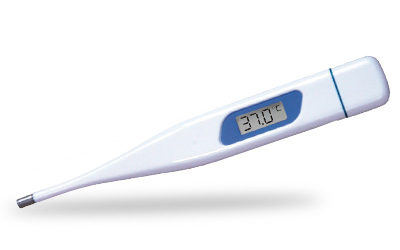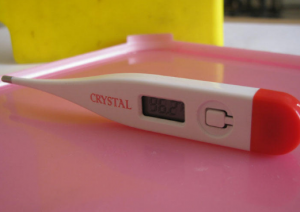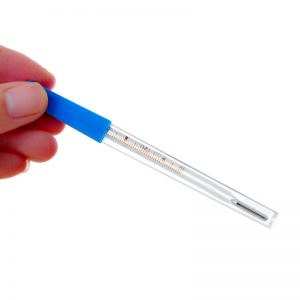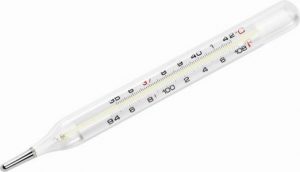Categories
Oral thermometer

Fever may be an alarming symptom in various conditions, including infections such as common cold, pneumonia, urinary tract infections, meningitis, etc. Other non-infectious causes that may result in elevated temperature include autoimmune diseases, cancer, tissue destruction and drugs side effects. In addition certain variations of body temperature during the day may be associated with specific conditions (malaria for example). On the other side extremely low body temperature (known as hypothermia) is also dangerous for the normal body functioning. This underlines the importance of accurate temperature measuring methods and instruments. There are still certain disagreements on what’s the normal temperature range as well as which is the most accurate method to measure it. However, oral temperature (along with rectal temperature), if taken correctly, is currently considered as very reliable.
Contents
Normal temperature, fever and hypothermia
Several facts should be taken into consideration when speaking of normal temperature
- Normal temperature varies through the day- temperature is at its lowest levels during sleep and it’s higher in the afternoon and during physical efforts
- Normal temperature range depends on the place where is taken (mouth, armpit, forehead, ear or anus)
- The accuracy of the measurement varies on the type of the thermometer- for example forehead patches are considered as relatively inaccurate
- Numerous external factors not related to health conditions could influence the temperature- such as environment temperature, emotional state, physical activity, etc
Fever is present when:
- Temperature measured in the mouth (oral temperature) is over 37.4 °C (or 99 °F)
- Temperature measured in the rectum (rectal temperature) is over 37.8°C –(or 100 °F)
- Temperature measured in the axilla (axillary temperature) is over 37.2 °C (or 99.0 °F)
- Temperature measured in the ear (tympanic temperature) is over 37.2 °C (or 99.0 °F)
or
or
or
Body temperatures below:
- 35.7 (96.3°F) for oral temperature
- 36.7 (98.1°F) for rectal temperature
- 35.5 (95.9 °F) for tympanic temperature
are considered as abnormally low. Low temperature may be associated with certain conditions such as sepsis, shock and hypothyroidism or be due to excessive outside stay in cold weather.
These values may vary depending on the model of the thermometer you use. Manufacturers usually provide information on the ranges for every different device that you should consult in order to interpret correctly the measured temperature.
How do oral thermometers work?
Oral temperature normal ranges vary between 36.4° and 37.4° C (97.6° and 99.3° F). Oral temperature can be measured through:
Digital oral thermometer
Digital oral thermometers are very accessible and easy to use. Many kinds of digital thermometers are available on the market and can be bought at either grocery stores or pharmacies. Generally, the tip of the thermometer contains thermistor that detects the physical temperature and converts it into electrical energy. Temperature is being measured for several seconds and the result is then being displayed on the LCD screen of the device. Most of the thermometers are equipped with a sound alarm that marks the end of the measurement. Another sound may be produced if fever is being detected. The majority of the digital thermometers also offer memory function. To obtain an accurate result, always follow the instructions provided by the manufacturer of the device.

In order to measure the temperature using a digital thermometer, you should keep its tip under your tongue, mouth firmly closed until you hear the beep-alarm. It usually takes 10 to 60 seconds, depending on the model you use. Clean the thermometer after each use.
Glass oral thermometer
Glass thermometers contain a tiny tube filled with liquid (usually ethanol), nitrogen and ethanol vapors. The liquid could be colored for easier interpretation of the results. As the alcohol is very sensitive to changes of temperature, when the temperature rises, it expands. The results are accounted through a graduated scale. Glass thermometer should be shaken before every use as alcohol and the air above could mix which would lead to false results.
If you are using a glass thermometer, you should remember to shake it before use in a way that the liquid line reaches a level under 35.6° (96 F). After placing it in your mouth, your lips holding it firmly, keep it under your tongue for three minutes before checking the result. Write down your temperature as you may need to compare it with previous or future recordings. It is important to place the thermometer right under your tongue and not anywhere else within your nouth.
Mercury containing thermometers are outdated and should not be used. They are officially banned for sale in many countries all over the world as mercury is highly toxic for the organism and the environment, including water, plants and animals. If you still possess mercury thermometer you should have in mind that if you accidently break it, you should not touch it in any case. If the thermometer is broken during oral temperature measurement, you should immediately look for a medical assistance. To avoid any risk, it is recommended to replace your mercury thermometer by digital one. Contact your pharmacist for advice on how to safely dispose the mercury based thermometer.
What are oral thermometers advantages?
Very accurate – compared to other methods, such as forehead or axillary measurement, the oral measurement of the temperature provides more reliable results. This is even especially important in children, where temperature measured on the body surface (for example the forehead) could be inaccurate and where small changes in temperature may have more severe consequences than in adults.
Easy to use – the risks of wrong results due to incorrect way of measurement are inferior for the oral thermometer than for the other types. For example tympanic thermometers results may be influenced by the quantity of wax within the ear, while axillary thermometers tip should be put deep in the armpit to be able to measure the temperature correctly and forehead contactless thermometers should be kept at specific distance.
Cheap and accessible – oral thermometers are sold in every drug store and in the most of the supermarkets. They are completely affordable with prices starting at several dollars. Moreover, the same thermometer could be used for years. The batteries of the digital thermometers are extremely power saving and could last for prolonged periods of time. If you don’t accidently break it, a glass thermometer will serve you for decades. On the other hand the digital oral thermometers are very durable as they are made of plastic and cannot be easily damaged. Some models even come with a lifelong guarantee.
Fast results – oral thermometers, especially digital ones provide very quick results- the temperature is being taken for as little as 10 seconds, which makes their use in non-cooperating patients easier, saves time and reduces the chance of compromised results due to the fact that the thermometer was not held in place for long enough
Possibilities to follow up the variation of the temperature – most of the patients underestimate the need of not only taking the temperature, but also analyzing its fluctuations. The digital oral thermometers offers memory function which is extremely useful when daily variations in temperature should be traced in order to establish the right diagnosis. For example malaria is characterized by periods of fever followed by periods of normal body temperature, while pneumonia is characterized by missing or inversed normal morning/afternoon variations. Memory function could also be helpful to evaluate the efficacy of the antipyretic therapy.
Comfortable – to measure the oral temperature is easier and more comfortable, especially for children, where it is recommended to use either oral or rectal temperature measurement. While rectal measurement could bring a certain discomfort, oral one is typically better tolerated. Plus, it is more hygienic.
What are oral thermometers disadvantages?
Dependence on external conditions – the accuracy of the oral thermometer, although high, could be influenced by external factors such as consummation of very hot or very cold drinks or foods. That is why it is recommended to measure the oral temperature at least 30 minutes before drinking or eating hot or cold meals. Smoking also interferes with the results and should be avoided for at least 20 minutes before taking the temperature.
Cooperation– the individual should be conscious and able to hold the thermometer still within his mouth for the amount of time necessary to measure it (typically between 8 and 60 seconds). This may pose problems in patients in coma or crying children that refuse to cooperate.
Fragility- glass oral thermometers could be broken during measurement by children who play with it with their teeth. In that way little glass particles could harm their mouth or be aspirated. That is why it is important to supervise the use of the thermometer in children. On the other hand glass thermometers could also be broken if dropped accidently.
Hygiene – many infections could possibly be transmitted if the thermometer is not cleaned well after every use. That’s why oral thermometer may not be the best option for medical cabinets or hospitals where the same thermometer will consecutively be used by a number of patients.
How to take care of your thermometer
In order to obtain the most accurate results and to prolong the life of your thermometer, you should always follow the instructions provided with it strictly.
Oral thermometer, whether it is digital or glass, should be disinfected with a cotton pad soaked with ethyl alcohol after every single use. Alternatively you could use water and soap. Never use hot water when washing a glass thermometer as it could break. In addition the tip of the thermometer should not be touched with unwashed hands (this is especially valid for children) or right after use as infection may be easily spread in that way.
Moreover, glass thermometers should be shaken before every use as the gas within tends to mix with the alcohol and this may lead to false results.
Always keep your thermometer in the case provided by the manufacturer.
Digital thermometer’s batteries are usually durable and may last for a couple of years without the need of replacement. However, this period may of course vary depending on the frequency of use of the thermometer. You will know that you need to replace the batteries when the digits on the display start to appear paler.
Why is oral thermometer more accurate than other ones?
As mentioned oral and rectal temperatures are more precise than axillary and forehead measurements. That is because oral and rectal thermometers actually measure the temperature within the body, while the other- the skin temperature. As skin temperature is easily influenced by numerous factors, it does not always correlates with core body temperature real value. For example skin could be warmer is you stay next to the fireplace. That does not necessarily mean that you have fever.
When could oral temperature be inaccurate?
Although oral thermometers are considered as precise, inaccurate results may be obtained if:
- The battery needs a replacement
- Consuming hot or cold drinks less than 30 minutes before the measurement
- Performing physical exercises an hour before taking the temperature
- Taking hot shower or tub right before
- Smoking right before
- Your mouth is not well closed while taking the temperature
- You hold the thermometer over instead of under the tongue
- You hold the thermometer for less time than needed
- You do not shake well the glass thermometer before using it
- You do not observe your child when taking its temperature , he may play with the thermometer or not keep his mouth closed as he is unaware of the importance of these conditions
Conclusion
Oral temperature measurement has its advantages and disadvantages. However, its relative accuracy, accessibility and ease of use, make it preferable over other methods. Inaccuracies are generally due to non-respect of some general rules and could be easily avoided. If you doubt that the measured temperature is correct you could recheck using another method. Once again- be careful as normal body temperature ranges vary according to how and where it is taken. When taking someone else’s temperature, especially children’s, make sure that they understand what is expected from them and observe if all the requirements for correct measurement are fulfilled.





